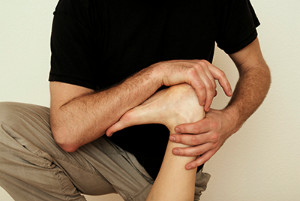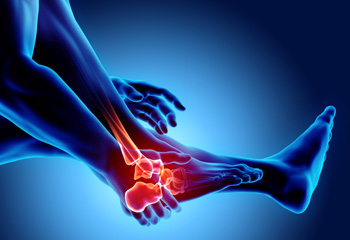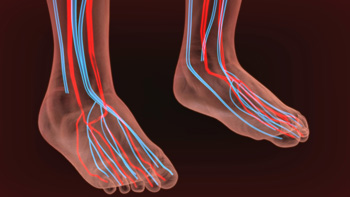Items filtered by date: September 2020
Three Foot Stretches
 The majority of people will pay attention to their feet when a foot problem develops. Conditions may develop as a result of wearing shoes that do not fit correctly, and some people find it beneficial to stretch their feet after wearing these shoes for most of the day. The heels may feel better when the calf muscles are stretched, and this is done by pressing your left shin into your right knee while on your hands and knees. Additionally, the arches may feel better when they are rolled on a tennis ball. The toes can be stretched while sitting back on the heels, and tucking the toes under. This may be beneficial in strengthening the gasping motion. Please consult with a podiatrist to learn more about effective foot stretches.
The majority of people will pay attention to their feet when a foot problem develops. Conditions may develop as a result of wearing shoes that do not fit correctly, and some people find it beneficial to stretch their feet after wearing these shoes for most of the day. The heels may feel better when the calf muscles are stretched, and this is done by pressing your left shin into your right knee while on your hands and knees. Additionally, the arches may feel better when they are rolled on a tennis ball. The toes can be stretched while sitting back on the heels, and tucking the toes under. This may be beneficial in strengthening the gasping motion. Please consult with a podiatrist to learn more about effective foot stretches.
Why Stretching Is Important for Your Feet
Stretching the feet is a great way to prevent injuries. If you have any concerns with your feet consult with Dr. Douglas Mckay from New Jersey . Our doctor will assess your condition and provide you with quality foot and ankle treatment.
Stretching the Feet
Stretching the muscles in the foot is an important part in any physical activity. Feet that are tight can lead to less flexibility and make you more prone to injury. One of the most common forms of foot pain, plantar fasciitis, can be stretched out to help ease the pain. Stretching can not only ease pain from plantar fasciitis but also prevent it as well. However, it is important to see a podiatrist first to determine if stretching is right for you. Podiatrists can also recommend other ways to stretch your feet. Once you know whether stretching is right for you, here are some excellent stretches you can do.
- Using a foam roller or any cylindrical object (a water bottle or soda can will do), roll the object under your foot back and forth. You should also exert pressure on the object. Be sure to do this to both feet for a minute. Do this exercise three times each.
- Similar to the previous exercise, take a ball, such as a tennis ball, and roll it under your foot while seated and exert pressure on it.
- Grab a resistance band or towel and take a seat. If you are using a towel, fold it length wise. Next put either one between the ball of your foot and heel and pull with both hands on each side towards you. Hold this for 15 seconds and then switch feet. Do this three times for each foot.
- Finally hold your big toe while crossing one leg over the other. Pull the toe towards you and hold for 15 seconds. Once again do this three times per foot.
It is best to go easy when first stretching your foot and work your way up. If your foot starts hurting, stop exercising to ice and rest the foot. It is advised that you then see a podiatrist for help.
If you have any questions, please feel free to contact one of our offices located in Caldwell, and Galloway, NJ . We offer the newest diagnostic and treatment technologies for all your foot care needs.
Foot Trauma Can Happen Gradually or Suddenly
 Injuries to the feet and ankles may occur as a result of gradual wear and tear, or from a sudden fall. Children who frequently participate in running and jumping activities may experience foot trauma from suddenly changing direction during soccer or football games. In older adults, muscle mass and bone strength can diminish, and their balance and vision may slowly deteriorate. Bruises can be common if an ankle sprain happens, and may be accompanied by severe pain and discomfort. A stress fracture is defined as a hairline crack in the bone, and can typically develop gradually from repetitive motion. If you have any type of pain in your feet or ankles, it is recommended that you confer with a podiatrist who can properly diagnose your condition and offer the correct treatment options.
Injuries to the feet and ankles may occur as a result of gradual wear and tear, or from a sudden fall. Children who frequently participate in running and jumping activities may experience foot trauma from suddenly changing direction during soccer or football games. In older adults, muscle mass and bone strength can diminish, and their balance and vision may slowly deteriorate. Bruises can be common if an ankle sprain happens, and may be accompanied by severe pain and discomfort. A stress fracture is defined as a hairline crack in the bone, and can typically develop gradually from repetitive motion. If you have any type of pain in your feet or ankles, it is recommended that you confer with a podiatrist who can properly diagnose your condition and offer the correct treatment options.
Foot and ankle trauma is common among athletes and the elderly. If you have concerns that you may have experienced trauma to the foot and ankle, consult with Dr. Douglas Mckay from New Jersey . Our doctor will assess your condition and provide you with quality foot and ankle treatment.
Foot and ankle trauma cover a range of injuries all over the foot; common injuries include:
- Broken bones
- Muscle strains
- Injuries to the tendons and ligaments
- Stress fractures
Symptoms
Symptoms of foot and ankle injuries vary depending on the injury, but more common ones include:
- Bruising
- Inflammation/ Swelling
- Pain
Diagnosis
To properly diagnose the exact type of injury, podiatrists will conduct a number of different tests. Some of these include sensation and visual tests, X-rays, and MRIs. Medical and family histories will also be taken into account.
Treatment
Once the injury has been diagnosed, the podiatrist can than offer the best treatment options for you. In less severe cases, rest and keeping pressure off the foot may be all that’s necessary. Orthotics, such as a specially made shoes, or immobilization devices, like splints or casts, may be deemed necessary. Finally, if the injury is severe enough, surgery may be necessary.
If you have any questions, please feel free to contact one of our offices located in Caldwell, and Galloway, NJ . We offer the newest diagnostic and treatment technologies for all your foot care needs.
Risk Factors for Peripheral Artery Disease
 Peripheral artery diseas, commonly known as PAD, is a condition that causes poor circulation to the lower limbs. PAD in the legs and lower extremities is the narrowing or blockage of the vessels that carry blood from the heart to the legs. This is caused by a buildup of fatty plaque in the arteries, which leads to the arteries hardening and constricting. Several risk factors can increase your chances of developing PAD, which include being a smoker, having high blood pressure, atherosclerosis, diabetes, high cholesterol, and being over the age of 60. Both men and women can develop PAD. For more information about peripheral artery disease and to get tested, please speak with a podiatrist today.
Peripheral artery diseas, commonly known as PAD, is a condition that causes poor circulation to the lower limbs. PAD in the legs and lower extremities is the narrowing or blockage of the vessels that carry blood from the heart to the legs. This is caused by a buildup of fatty plaque in the arteries, which leads to the arteries hardening and constricting. Several risk factors can increase your chances of developing PAD, which include being a smoker, having high blood pressure, atherosclerosis, diabetes, high cholesterol, and being over the age of 60. Both men and women can develop PAD. For more information about peripheral artery disease and to get tested, please speak with a podiatrist today.
Peripheral artery disease can pose a serious risk to your health. It can increase the risk of stroke and heart attack. If you have symptoms of peripheral artery disease, consult with Dr. Douglas Mckay from New Jersey . Our doctor will assess your condition and provide you with quality foot and ankle treatment.
Peripheral artery disease (PAD) is when arteries are constricted due to plaque (fatty deposits) build-up. This results in less blood flow to the legs and other extremities. The main cause of PAD is atherosclerosis, in which plaque builds up in the arteries.
Symptoms
Symptoms of PAD include:
- Claudication (leg pain from walking)
- Numbness in legs
- Decrease in growth of leg hair and toenails
- Paleness of the skin
- Erectile dysfunction
- Sores and wounds on legs and feet that won’t heal
- Coldness in one leg
It is important to note that a majority of individuals never show any symptoms of PAD.
Diagnosis
While PAD occurs in the legs and arteries, Podiatrists can diagnose PAD. Podiatrists utilize a test called an ankle-brachial index (ABI). An ABI test compares blood pressure in your arm to you ankle to see if any abnormality occurs. Ultrasound and imaging devices may also be used.
Treatment
Fortunately, lifestyle changes such as maintaining a healthy diet, exercising, managing cholesterol and blood sugar levels, and quitting smoking, can all treat PAD. Medications that prevent clots from occurring can be prescribed. Finally, in some cases, surgery may be recommended.
If you have any questions, please feel free to contact one of our offices located in Caldwell, and Galloway, NJ . We offer the newest diagnostic and treatment technologies for all your foot care needs.
What Is an Ingrown Toenail?
 Patients who have ingrown toenails are often aware of the pain and discomfort they may cause. It occurs as a result of the outer edge of the nail digging into the surrounding skin, and generally affects the big toe. Common causes of ingrown toenails can include improperly trimming the toenails, in addition to wearing shoes that do not have adequate room for the toes to move freely in. Mild relief may be found when the affected foot is soaked in warm water, and the nail is gently pulled away from the skin. If you are afflicted with an ingrown toenail, it is recommended that you consult with a podiatrist as quickly as possible, who can effectively treat this condition, and offer prevention techniques.
Patients who have ingrown toenails are often aware of the pain and discomfort they may cause. It occurs as a result of the outer edge of the nail digging into the surrounding skin, and generally affects the big toe. Common causes of ingrown toenails can include improperly trimming the toenails, in addition to wearing shoes that do not have adequate room for the toes to move freely in. Mild relief may be found when the affected foot is soaked in warm water, and the nail is gently pulled away from the skin. If you are afflicted with an ingrown toenail, it is recommended that you consult with a podiatrist as quickly as possible, who can effectively treat this condition, and offer prevention techniques.
Ingrown toenails can become painful if they are not treated properly. For more information about ingrown toenails, contact Dr. Douglas Mckay of New Jersey . Our doctor can provide the care you need to keep you pain-free and on your feet.
Ingrown Toenails
Ingrown toenails occur when a toenail grows sideways into the bed of the nail, causing pain, swelling, and possibly infection.
Causes
- Bacterial infections
- Improper nail cutting such as cutting it too short or not straight across
- Trauma to the toe, such as stubbing, which causes the nail to grow back irregularly
- Ill-fitting shoes that bunch the toes too close together
- Genetic predisposition
Prevention
Because ingrown toenails are not something found outside of shoe-wearing cultures, going barefoot as often as possible will decrease the likeliness of developing ingrown toenails. Wearing proper fitting shoes and using proper cutting techniques will also help decrease your risk of developing ingrown toenails.
Treatment
Ingrown toenails are a very treatable foot condition. In minor cases, soaking the affected area in salt or antibacterial soaps will not only help with the ingrown nail itself, but also help prevent any infections from occurring. In more severe cases, surgery is an option. In either case, speaking to your podiatrist about this condition will help you get a better understanding of specific treatment options that are right for you.
If you have any questions please feel free to contact one of our offices located in Caldwell, and Galloway, NJ . We offer the newest diagnostic and treatment technologies for all your foot and ankle needs.


